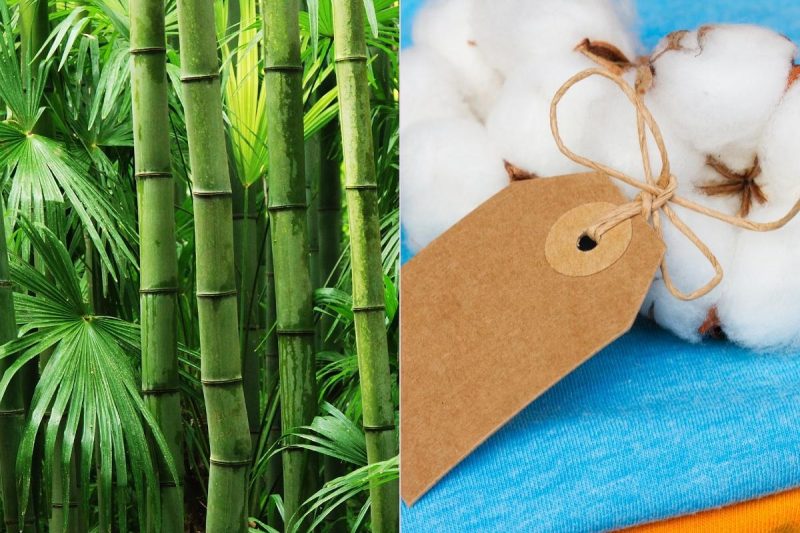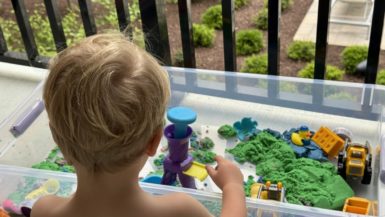Every parent wants the best for their baby, so it’s not surprising that many parents are looking for the softest and best baby clothes. While we’re bombarded with baby pajamas everywhere, there’s a huge difference in quality and other features when it comes to brands and materials.
This is why many parents reach for organic cotton or bamboo viscose baby pajamas. Both of these often cost more but are of higher quality, feel softer, and claim to be hypoallergenic, which is important to babies with sensitive skin.
Is bamboo viscose better than organic cotton? Fans of either material will tell you that one is better than another, but I’ll be real: while I’m a big fan of bamboo clothes and we have a lot (myself included, not just my kids) there’s no one clear winner. It all depends on various factors. Personally, I dress my kids in both depending on the age and occasion.
Let’s take a look at both materials and what is the best and softest fabric for baby clothes.
What’s So Great About Bamboo Viscose Baby Pajamas?
Longevity of Bamboo
Bamboo viscose / bamboo rayon is extremely stretchy and to a certain extent, it stretches with your child. Most babies grow out of their clothes every few weeks which can be costly and annoying.
To give you a real-life example my baby went through sizes 6-9m, 9-12m, 12-18m and almost growing out of 18-24m in organic cotton footies, while still wearing his 9-12m footie from Posh Peanut (photo below). He’s wearing it comfortably, as I’d never stuff him in clothes that are way too small.
Needless to say, you actually end up spending less on baby clothes even though the cost per item is more expensive.
When it comes to toddlers I’d say the longevity depends. My toddler is extremely active and we use bamboo pajamas to lounge as well so after half a year I do feel like his pajamas can use a revamp (meet your new best friend for taking care of bamboo clothes: fabric shaver).
While some say that bamboo fabric is less durable, I honestly never got a hole yet… well, apart from that time when my then 18-month-old decided he was going to try his new scissors on his closet, but let’s not blame bamboo for that as even jeans got a makeover that day 😉

Is Bamboo Viscose and Bamboo Rayon the Same Thing?
Many people and companies use viscose and rayon interchangeably, but technically speaking the clothes and sheets you buy are bamboo viscose. First, you create rayon from the bamboo plant and then turn it all into viscose.
Comfort of Bamboo Viscose
You might have noticed that past 9 months of age baby and toddler pajamas get tight and have yellow tags telling you that the material is not fire-resistant (if they don’t have that stay away, as it means they’re sprayed with toxic chemicals). Painfully tight to be precise, as it’s due to an outdated flammability act.
Tight-fitting pajamas can be uncomfortable to move around and if the material is stiffer it can limit the possibility of a toddler dressing himself, which is very important for Montessori children.
Bamboo rayon clothes aren’t sprayed with chemicals, which means they need to be tight as well, but due to their stretchiness, it’s not uncomfortable at all and my son can dress and undress on his own. I had to get rid of some very fancy and beautiful organic cotton pajamas as they were too difficult to put on, especially in sleeves, and I felt like it was almost cutting his circulation (and I do have a skinny toddler, so cannot even imagine how a chunkier toddler could comfortably wear it). In this aspect, bamboo baby pajamas are the clear winner.
Once you touch the fabric you’ll understand why people love it so much: bamboo viscose is extremely soft. It feels just as soft as cashmere. I’m yet to meet a child who hates the bamboo material – every single child I gifted some clothes or blankets is amazed at how soft it is and wants to only sleep with or in it.
In terms of taking care of bamboo clothes, most people will tell you not to throw the clothes in the dryer. Some might find it frustrating and still do that, but for me, it’s a wonderful solution, especially when traveling as bamboo clothes air dry incredibly fast and don’t get stiff like some cotton clothes when air-dried. You don’t need to iron bamboo pajamas either, which saves time.
Check out where to get your bamboo baby clothes
Is Bamboo Fabric Sustainable?
At a glance, bamboo seems like a very good choice for a sustainable crop because the bamboo plant is fast-growing, requires no fertilizers, and can self-regenerate from its own roots. That said, the bamboo plant is organic and can be very eco-friendly, but that doesn’t necessarily mean that it’s being grown sustainably.
The majority of bamboo is being grown in China and there is no information on how intensively bamboo is being harvested or grown as the market is expanding. Just because bamboo does not need pesticides there is no guarantee that they are not being used to maximize outputs, so you shouldn’t buy bamboo viscose clothing from a random seller.
Bamboo products are also advertised for their antimicrobial qualities, which help reduce and destroy odor-causing bacteria, but that part isn’t correct. While pure bamboo is indeed antimicrobial and antifungal viscose from bamboo (the fabric used for clothes) loses these features in the material production process. It doesn’t take away from the bamboo fabric qualities, to be honest, but it’s a fact.
Unlike it’s often advertised, bamboo fabric is not antifungal and antimicrobial. Kun is found naturally in the living bamboo fiber and the Kun is indeed antibacterial, antifungal, and odor-resistant. But these features are lost during the production of the material and real bamboo fabric that may be antibacterial (there’s no actual proof of that and in fact, FTC asks to report any company that claims otherwise) is often rough or scratchy, and is rarely used in a fabric you touch like viscose.
You really don’t need to worry about that part, but keep in mind that bamboo baby pajamas isn’t protecting your baby’s skin from UV lights.
However, let’s not demonize bamboo viscose altogether. No alternative can provide a holistic benefit to the environment and the consumer that can be compared to bamboo (read further on cotton issues as well). Bamboo clothing (regardless of whether it’s mechanically and chemically manufactured) is 100% biodegradable and can be completely decomposed in the soil by micro-organisms and sunlight without decomposing into any pollutants such as methane gas which is commonly produced as a by-product of decomposition in landfills and dumps.
I’d argue that despite the chemical production process bamboo viscose is a lot better and safer than losing 40,000 people per year through pesticide use thanks to traditional cotton production.
Products made of bamboo rayon are not biodegradable because they will not break down in a reasonably short time after customary disposal, so most commercial bamboo labels on the market are not as “eco-friendly” as advertised. Nevertheless, bamboo baby pajamas, are more eco-friendly than typical cotton clothing that isn’t organic.
Are bamboo viscose, organic cotton, and hemp perfect solutions to all our textile-related environmental issues? No.
Are bamboo and cotton better solutions versus conventional cotton and synthetics such as polyester? A 100% yes. Things are not always black or white when it comes to clothing production.

Are Bamboo Clothes Organic?
Short answer, no. Bamboo clothes are NOT organic. While trendy and pricier than cotton, bamboo material is not organic because of the way it’s produced. It’s a chemical process like the production of polyester or modal. It may look like a natural fiber as it’s created from a plant, but it doesn’t behave like one. A regenerated fiber such as viscose rayon is not natural, which is further affirmed by the Federal Trade Commission.
Because of the potential health risks during the production of the material and damage to the environment surrounding the manufacturing facilities, textile manufacturing processes of bamboo or other regenerated fibers using hydrolysis alkalization with multi-phase bleaching are not considered sustainable or environmentally supportable.
It’s also why there are no rayon producers in the US. It’s too toxic a process to comply with the EPA’s standards and workers are at high risk inside the factory and then you need to make sure that these chemicals aren’t being dumped into the waterway. Unfortunately, there is evidence that many factories in India and China are dumping chemicals to local villages and poisoning the water, so keep in mind that if you’re buying from a random company or website of cheap dupes you don’t know how ethical the factory might be.
Is there a solution? Look for OEKO-TEX certified companies, which means it was produced in a facility that takes the necessary safety and environmental precautions.
The only variant of bamboo that can be organic and doesn’t use chemicals is called lyocell (or even some linen can be produced mechanically), but that’s not used for children’s clothes at the moment. Tencel, Excel, or Monocel are also registered trademarks for bamboo lyocell.
You might start wondering then…
Is Bamboo Fabric Safe for Babies?
Absolutely! There’s been a frenzy that bamboo fabric is toxic, but it’s absolutely not true. If the production of the material isn’t done correctly the production process might be, but there are a few companies that know the factory they’re sourcing their fabrics.
Bamboo viscose can be Oeko Tex Standard 100 certified. OekoTex aims to demonstrate that there are no harmful chemicals in the finished fiber.
Basically, if you buy from a reputable company that doesn’t make false claims then you have nothing to worry about.

What’s Better for Your Child: Bamboo or Organic Cotton?
You might be wondering if purchasing organic cotton sleepwear is worth the added expense, especially since you can see plenty of cotton or partially cotton clothes at popular department stores. Yes, it is worth the extra cost, to be honest.
Is organic cotton better than bamboo? Comfort-wise I wouldn’t say that, but I think it varies case by case.
Sustainability of Organic Cotton
What is the difference between non-organic and organic cotton?
Organic cotton fabrics are superior to conventionally grown cotton fabrics because they are grown without synthetic fertilizers, pesticides, or fungicides. Non-organic conventional cotton has many negative health environmental impacts like pesticides, insecticides, and chemical run-off are often a result of conventional cotton production. If you’re into eco and organic items, organic cotton will be the best choice for you, since bamboo viscose isn’t organic material.
This produces healthier products for consumers while protecting our valuable ecosystems, but let’s not be fooled: growing cotton in the first place also takes a toll on the environment as nothing is black or white entirely. Every one kg of cotton lint production requires 10,000 – 17,000 liters of water, which isn’t great for the environment either, so it’s not a perfect solution either.
The only downside to organic cotton is that it’s very difficult to grow without chemicals. As a result, the process of organic growing is more labor-intensive than conventional methods (using synthetic pesticides and fertilizers) and if abused can result in overworked factory workers.
Fabrics made from organic cotton are also much softer and more durable because the fibers have not been exposed to harsh synthetic chemicals that can break down natural fibers.
If your child crawls intensively or plays hard (like my older one when he was about 10 months old) most bottoms lasted him about 2 weeks at the most before we got holes in them so at this stage cotton made much more sense than bamboo for him, as he’d go through bamboo bottoms or footies in a few days.
Check out top companies to buy organic cotton baby clothes

Breathability of Cotton vs Bamboo
Bamboo rayon clothing is incredibly breathable which makes it superior at first glance. As a family who spends months every year in Mexico where it’s hot and humid, bamboo viscose is a great solution for this weather as it doesn’t make anyone as sweaty as in cotton clothes.
Although, bamboo isn’t a miracle fabric – your child will still sweat in bamboo if it’s hot.
However, it makes bamboo baby pajamas slightly less warm for the winter, and not every child wants to wear multiple layers when it’s really cold. That said, for some who live in very cold places bamboo might not work for the winter.
On the other hand, I’m yet to find anyone whose baby had irritated skin in bamboo clothing. If your child has eczema or gets skin rashes easily you might need to switch to bamboo or 100% organic cotton. 100% organic cotton is quite tough to find in the US (in Europe it’s very accessible).
For a very long time I thought that babies could be fine in most things until my family started buying my older son lots of cheap popular baby clothes and Dylan ended up with horrible eczema outbreaks instantly… something I only realized recently.
Conclusion: Bamboo Baby Pajamas vs Cotton Baby Pajamas
Don’t get me wrong, especially in the winter my kids wear both organic cotton and bamboo, also because there’s not a lot of daywear for boys in the bamboo toddler clothing department (although many companies are expanding their collections of daywear for boys).
If you’re an eco-conscious family then definitely go for organic cotton.
I noticed that I like bamboo more and if more companies started making more cute-looking daywear for boys I’d probably get some more daywear for my kids as well.






Loved this! Which brands do you recommend for bamboo PJs? I noticed you mentioned Posh Peanuts but they have 5% spandex 🫠
All bamboo brands will contain spandex (between 3 to 8%), there’s no way around it. The least amount 3% you can find at Kyte Baby.